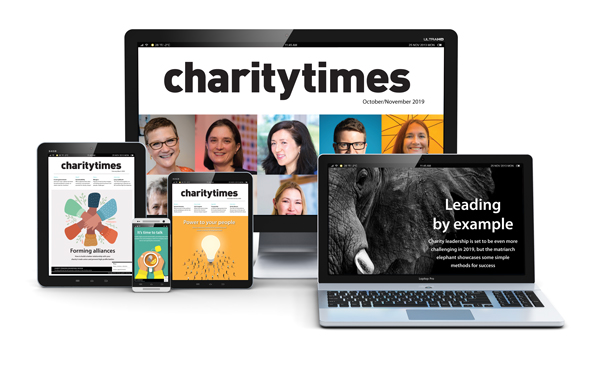It is now widely recognised that the climate and biodiversity crises require urgent attention. Their impact on our day-to-day life, even away from the front lines of their effects, has become too pressing to ignore. Simultaneously, it is clear that protecting the earth and its natural resources is a collective human responsibility. But how should we meet this daunting task?
For those of us – both individuals and businesses – keen to play our part in creating a sustainable future, philanthropy is an obvious choice. But whilst familiar forms, such as one-off donations, fundraising events and donation drives, undoubtedly reflect good intentions and can have positive effects, the reality is they do not always translate into the support communities at the coal face of the issue need.
Long term partnerships between corporate supporters and local communities can offer organisations and individuals looking to build a more sustainable future a model of giving that truly makes a difference, while also delivering reciprocal benefits. But how can charities manage these partnerships sensitively and efficiently?
In the globalised economy, the environmental crises can feel universal, but for communities on the front lines of their effect, the impact feels highly localised. As such, co-designed funding programmes which platform the voices of local communities can help to ensure that funding is channelled and ringfenced for their immediate priorities. After all, the best solutions will only follow an accurate picture of a problem.
These genuine partnerships are a vital step in achieving the most effective use of funding and charities can embed this approach by ensuring their own diversity of board. If a variety of perspectives are valued at the top levels of an organisation, it leaves parties open and familiar with a two-way flow of knowledge and influence. This collaboration should also extend to other stakeholders on the ground, involving the voices of experts and scientists where relevant, as well as working with local governments to ensure sustainability targets are met across the board.
Embedding a close, co-designed approach where supporter and community are constantly inspiring one another goes both ways in allowing innovation and creativity to flow. Following a virtual immersion session about our flagship Communities for Nature partnership, ‘Actions for Communities and Environment’ between UK-based fintech LMAX Group and The Philippine Reef and Rainforest Conservation Inc. (PRRCFI), LMAX Group employees were inspired to use their technical skills to support the local community by designing a customized ‘smart’ buoy to help with ocean monitoring.
Placing emphasis on collaborative partnerships means that funding and initiatives can also have the opportunity to reach those who may not ordinarily get a seat at the table. By placing emphasis on the needs of a local community as a whole, positive knock-on effects can be felt by a wider base. A sustainable future can mean more than just broad schemes for environmental conservation and be extended to initiatives promoting sustainable tourism, for example. To ensure the effectiveness of such initiatives, it is vital that conversations are had with those taking part to determine where priorities lie, mapping existing skillsets against where they would like to be; allowing corporates to provide funding for targeted assistance where it is most needed.
Ultimately, this approach is about communication and knowledge sharing – or in other words, education. Placing education at the heart of charitable giving not only secures the legacy of positive actions for future generations, but also allows knowledge to flow from community to supporter and vice versa. As such, partnerships should always consider how their initiatives can incorporate youth or create opportunities for reciprocal knowledge sharing in order to teach.
For example, at Communities for Nature, we do this through channeling ACE funding into youth and mature marine camps, where participants identify the most pertinent marine issues affecting their communities and any potential solutions before we provide them with resources and training that help make the solutions a reality. We have also produced a programme update magazine where LMAX can learn about the initiatives PRRCFI are undertaking in the Philippines, thus keeping education centre stage at all levels of the partnership.
We all want to fund purposeful action with a long-term impact. As Baba Dioum, speaking at the General Assembly of the International Union for the Conservation of Nature and Natural Resources said in 1968: "In the end we will conserve only what we love, we will love only what we understand, and we will understand only what we are taught." So let’s ensure we are listening.
Charity Times video Q&A: In conversation with Hilda Hayo, CEO of Dementia UK
Charity Times editor, Lauren Weymouth, is joined by Dementia UK CEO, Hilda Hayo to discuss why the charity receives such high workplace satisfaction results, what a positive working culture looks like and the importance of lived experience among staff. The pair talk about challenges facing the charity, the impact felt by the pandemic and how it's striving to overcome obstacles and continue to be a highly impactful organisation for anybody affected by dementia.
Charity Times Awards 2023
Mitigating risk and reducing claims

The cost-of-living crisis is impacting charities in a number of ways, including the risks they take. Endsleigh Insurance’s* senior risk management consultant Scott Crichton joins Charity Times to discuss the ramifications of prioritising certain types of risk over others, the financial implications risk can have if not managed properly, and tips for charities to help manage those risks.
* Coming soon… Howden, the new name for Endsleigh.
* Coming soon… Howden, the new name for Endsleigh.
Better Society

© 2021 Perspective Publishing Privacy & Cookies











Recent Stories